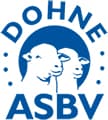Understanding Dohne ASBVs
AUSTRALIAN SHEEP BREEDING VALUES (ASBVs)
Australian Sheep Breeding Values (ASBVs) describe the expected performance of the progeny of a sheep, not just the performance of the sheep itself. An ASBV therefore describes the breeding value of the sheep – and as a breeder isn’t that what you want to know.
Dohne ram breeders produce ASBVs for major measured performance traits, including number of lambs weaned (NLW), maternal weaning weight (MWWT), live weight (WT), muscle depth (EMD), fat depth (Fat), fleece weight (CFW), fibre diameter (FD) and coefficient of variation (CV) of FD.
Dohne ASBV performance is based on the measured evaluation made by the ram breeder. The measurement is then value added by accounting for factors that breeders recognise can improve the ability of the measured performance to describe a sheep’s breeding value. Factors accounted for include the trait heritability, if the sheep was a twin or single, date of birth of the sheep, maiden or adult dam age, the sheep’s pedigree (relative’s) performance and difference in environment between groups.
Pedigree performance records allow ASBVs to be compared across-years and flocks. Dohne rams and ewes from large and small Registered Dohne ram breeding flocks can in this way be directly compared.
A Dohne ASBV describes the expected performance of a Dohne’s progeny for a trait relative to the performance of all Registered Australian Dohne ram breeding flocks.
Understanding Dohne ASBVs – A5 Sale Catalogue Printout
Understanding Dohne ASBVs
THE DOHNE INDEX
Dual purpose 9% MP
The Dohne index summarises into one number the performance of a Dohne for measured traits – number of lambs weaned, weaning and yearling weight, muscle depth, fat depth, fleece weight, fibre diameter and CV of fibre diameter. Having one number to use simplifies and improving the accuracy of selections. The balance in which traits are combined matches the Dohne Breeding Objective.
- improve reproduction, growth rate, muscle depth and reduce fibre diameter,
- maintain fat depth, fleece weight and staple strength.
Meat traits contribute approximately 75% of the commercial flock gain and wool traits 25%. The Dohne index is based on a 9% MP (micron premium) wool market and high return lamb market that values high growth and reproduction.
YOUR BENCHMARK TO THE CURRENT DOHNE STANDARD
Percentile Band Table
A guide to the performance of a registered Dohne relative to the current Dohne breed standard (2013 drop – the most recent drop) is reported in the percentile band table. For example, if a Dohne ram (or ewe) has a yearling weight (YWT) ASBV of 5.2 this sheep is in the highest 20% for YWT when compared with the current Dohne standard. That is they have a higher YWT than the 20% band (5.0kg). The sheep is not the highest 10% as they would need to have an ASBV of 5.7 or higher. In this context ‘highest’ means the extreme end of performance for a trait; it does not indicate ‘best’ as best is defined by a breeder’s objective.
An ASBV of 0.0 (zero) is the average of the 2000 drop ram breeding flocks. The 50 percentile band is the average of the current drop, eg. YWT is 3.7kg
Latest Dohne Percentile Band Table
TRAITS ABBREVIATIONS
NLW: number of lambs weaned
MWWT: maternal weaning weight
WT: bodyweight
EMD: eye muscle depth
Fat: fat depth
CFW: clean fleece weight
FD: fibre diameter
CV: coefficient of variation of FD)
AGE ABBREVIATIONS
W: Weaning
PW: Post Weaning
Y: Yearling
EXAMPLE
YWT = yearling bodyweight
For further information contact Dohne Database
Brett Wilson 0411 541 034
Email data@dohne.com.au










 Facebook
Facebook YouTube
YouTube Instagram
Instagram